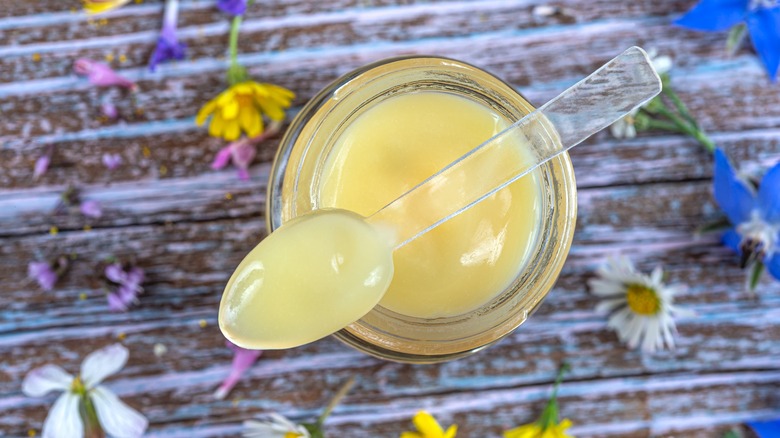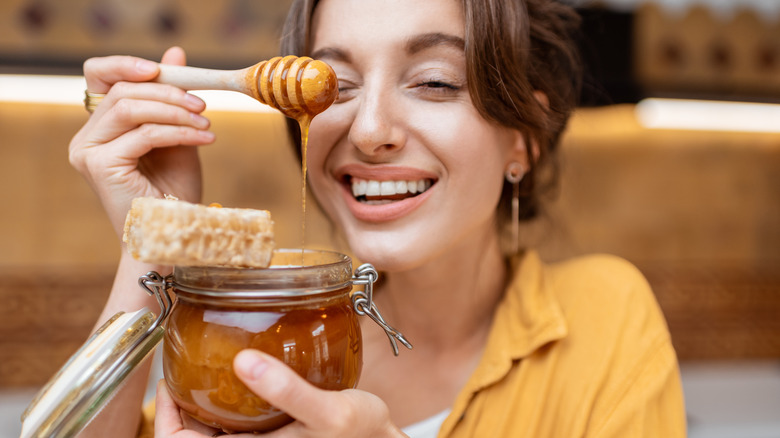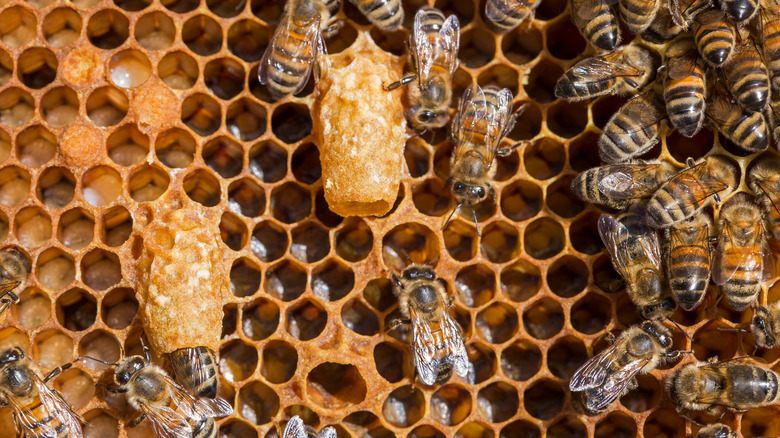Health Benefits Of Royal Jelly
Listen up, honey! A new health trend has hit the scene and it's got everybody buzzing. It's called royal jelly, and it hasn't got a thing to do with what Queen Elizabeth spreads on her toast. Royal jelly — also commonly referred to as bee milk — is a viscous and highly nutritious substance secreted from the glands of worker bees. In the first three days post-hatching, all bee larvae feed on royal jelly to help them grow big and strong, but only the bees destined to be queens will continue to feed exclusively on royal jelly after that (per Brittanica).
With our knack for being able to make any and everything about us, humans have found a way to harvest royal jelly and use it to try and make us stronger, too! Let's take a closer look at all the potential health benefits, as well as the downsides, of this magical monarchical goo.
Royal jelly can be beneficial for women's health
It is important to note that while there is a growing list of potential health benefits associated with the use of royal jelly based on some human and animal studies, Verywell Health reported that both the U.S. Food and Drug Administration (FDA) and the European Health Safety Authority have concluded that there isn't sufficient evidence to support any of them. The FDA is cracking down on those who make unsubstantiated claims about the benefits of using royal jelly.
With that being said, some research has indicated that royal jelly might aid in symptoms associated with premenstrual syndrome (PMS) and menopause. A study published in Complementary Therapies in Medicine reported that women who took capsules containing royal jelly through two menstrual cycles experienced significantly greater relief from PMS symptoms than those in the control group.
One study published in Climacteric reported findings that royal jelly helped ease depression and enhance memory in postmenopausal rats. Adding to the evidence supporting royal jelly's mood-boosting properties, a study published in Evidence-Based Complementary and Alternative Medicine found that postmenopausal women given 800 milligrams of royal jelly every day for 12 weeks reported having less anxiety.
Are there more benefits to royal jelly?
Catering to the constant quest for youthful, glowing skin, many topical anti-aging products boast about the inclusion of royal jelly on their ingredient list. Two studies published in the Journal of Medicinal Foods carried out by members of the same research team claim that royal jelly might help increase collagen production as well as protect skin from being damaged by ultraviolet (UV) rays. However, it is important to note that the first study was only performed on rats, and the latter study stressed that UV protection was merely a potentiality.
One test-tube study published in Scientific Reports found that the proteins in royal jelly can relax the smooth muscles in the arteries and veins of mice, which might make it effective in lowering blood pressure. However, WebMD warns against using royal jelly if you are already taking any medications designed to lower blood pressure, as it may cause blood pressure to drop below healthy levels.
There is a negative side to royal jelly
Despite the FDA's lack of approval, royal jelly is generally considered safe to use. However, Healthline reports that because it is a bee product, those with bee and pollen allergies should exercise caution. Some adverse reactions have been reported, from contact dermatitis to life-threatening anaphylactic shock.
Due to the tactics used to harvest royal jelly, using it for our own benefit is a sticky situation in terms of ethicality. Quercus Honey and Health, a bee-keeping operation based in South Africa, condemns the harvesting of royal jelly, calling it "a matter of conscience." They report that in order to gather the substance, the hive is infiltrated and the cells containing four-day-old larvae are cut open. The larvae are then plucked out with tweezers before being discarded, and the royal jelly in the cell is then scraped out and frozen. Another tactic involves removing a hive's queen. The worker bees, thrown into a tizzy over being orphaned, begin filling cells of the hive with royal jelly in a desperate attempt to raise a new queen. These cells are then drained using a mechanical instrument, and once that is done, the entire swarm is often poisoned as they are rendered useless.




